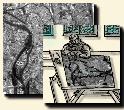 |
 |
![]()
Linear Features
Roads, highways, railways, rivers and canals are linear features.
A satellite image (SPOT P)

Detection of road and hydrographic network were the subject of many studies, especially in the field of aerial images. The resolution of these aerial images makes it possible to consider a detection based on texture, which cannot be the case, currently, for satellite images.
However, the constraints characterizing the linear objects remain valid for the images of lower resolution. The formalization developed in this research allows a good approach of the problems. In particular, with a low resolution approach based on under-sampled aerial images, roads and rivers appear fine homogeneous lineaments. The study of documents relating to satellite images brings information more specific to this type of images and more adapted methods of processing.
It should however be noticed that a road can have a variable width on the images, because of a phenomenon of discretisation, whereas they are generally of constant width.
Independently of their functional aspect, the geographical objects are characterized by different properties, related to the knowledge contained in the image to process, but also to external knowledge.
This knowledge makes it possible either to guide the extraction of the geographical objects, or to attach a detected and unknown object to a geographical class, in the aim of enriching a data base, for instance.
Characteristics of linear features can be described as follows:
| Objects | Thickness | Profile | Curvature |
| Roads | 1 to 3 pixels | valleys on XS3, generally ridges on P | medium to high |
| Highways | 3 to 4 pixels | valleys on XS3, generally ridges on P | weak |
| Railways | Narrow | valleys on XS3, generally ridges on P | weak |
| Rivers | Narrow | valleys on P and XS2 | very high |
| Canals | 3 to 6 pixels | valleys on XS3, valleys on P and XS2 | high |
These rules are used to select the operators and tune the parameters at each step of the process. Thickness is used to select and tune the detectors. Profile selects the type of fusion. Curvature adjusts the behavior of the curve smoothing process.
![]()